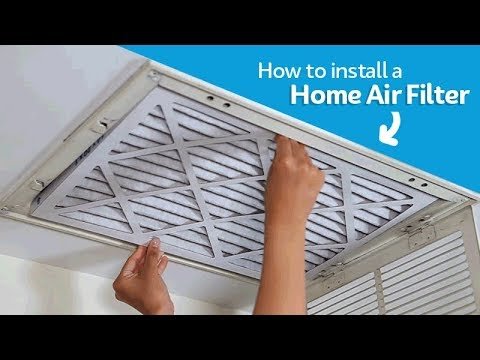To put in an air filter, make sure you have the right replacement filter for your specific make and model of vehicle. Begin by locating the air filter housing, usually found under the hood. Open the housing and remove the old filter, paying attention to its orientation. Then, simply slide the new air filter into place, ensuring it is properly seated before closing the housing. Regularly replacing your air filter is crucial for maintaining optimal engine performance and fuel efficiency. Follow these steps to easily complete this essential maintenance task.
How to Put in an Air Filter: A Step-by-Step Guide
Are you ready to learn how to put in an air filter for your home? Changing your air filter is a simple yet crucial task that can improve the air quality in your living space and help your HVAC system run more efficiently. In this comprehensive guide, we will walk you through the process step by step, so you can breathe easier and enjoy a healthier home environment.
The Importance of Changing Your Air Filter
Before we dive into the steps of putting in an air filter, let’s first understand why it’s important to change your air filter regularly. Your air filter plays a vital role in trapping dust, pollen, pet dander, and other airborne particles, preventing them from circulating in your home. Over time, the filter can become clogged, reducing airflow and making your HVAC system work harder to maintain the desired temperature.
By changing your air filter regularly, typically every 1 to 3 months depending on the type of filter and your household’s needs, you can:
– Improve indoor air quality
– Extend the lifespan of your HVAC system
– Increase energy efficiency and lower utility bills
Now, let’s get started on how to put in an air filter with our step-by-step guide.
Step 1: Gather Your Supplies
Before you begin, make sure you have all the necessary supplies on hand:
– New air filter (make sure to purchase the correct size and type for your HVAC system)
– Gloves (optional but recommended to keep your hands clean)
– Rag or paper towels for cleaning any dust around the filter area
– Pen and paper to note down the date of the filter change
Step 2: Locate Your Air Filter
The next step is to locate the air filter in your HVAC system. The air filter is usually located behind the return air grille on the wall or ceiling, or inside the HVAC unit itself. Refer to your HVAC system’s manual if you’re unsure where the air filter is located.
Step 3: Remove the Old Air Filter
Once you’ve located the air filter, it’s time to remove the old one. Carefully slide out the old filter from its slot, taking note of the direction of airflow indicated on the filter frame (if applicable).
If the filter is dirty or clogged, use your rag or paper towels to clean the surrounding area to prevent any dust or debris from entering the HVAC system.
Step 4: Insert the New Air Filter
Now, it’s time to insert the new air filter. Make sure the arrow on the filter frame is pointing in the direction of the airflow, typically towards the blower motor. Slide the new filter into place, ensuring it fits snugly within the slot.
Step 5: Secure the Filter in Place
Once the new filter is in position, double-check to ensure it is securely in place and there are no gaps around the edges. A properly installed filter will prevent air from bypassing the filter and ensure maximum filtration efficiency.
Step 6: Note the Date of the Filter Change
To keep track of when you last changed the filter, use your pen and paper to note down the date of the filter change. This will help you remember when it’s time to replace the filter again in the future.
Step 7: Dispose of the Old Filter
Properly dispose of the old air filter by placing it in a plastic bag to contain any dust or debris it may have collected. Check with your local waste management guidelines on how to dispose of air filters responsibly.
Step 8: Enjoy Cleaner Air and Improved HVAC Performance
Congratulations! You’ve successfully put in a new air filter for your HVAC system. By following these simple steps and changing your air filter regularly, you can enjoy cleaner air, improved HVAC performance, and potentially lower energy bills.
Remember to set a reminder to check your air filter every 1 to 3 months and repeat the process as needed. Your lungs and your HVAC system will thank you!
In conclusion, putting in an air filter is a straightforward task that can have a significant impact on your indoor air quality and HVAC system’s efficiency. By following this step-by-step guide, you can easily change your air filter and reap the benefits of cleaner air and improved performance. Take the time to care for your home’s air quality, and breathe easy knowing you’re creating a healthier environment for you and your family.
Air filter Instructions for “Dummies “ #airfilter #hvac #furnace
Frequently Asked Questions
How do I know when to change my air filter?
It is recommended to check your air filter every 12,000 to 15,000 miles, or as indicated in your vehicle’s manual. Signs that your air filter needs changing include reduced airflow, decreased fuel efficiency, or a visibly dirty filter. Regular inspection and maintenance will help keep your engine running smoothly.
What tools do I need to replace an air filter?
Replacing an air filter is a relatively simple task that usually requires no special tools. Typically, you will only need a screwdriver to access the air filter housing. Ensure you have a new, compatible air filter ready before you begin the replacement process.
How often should I replace my car’s air filter?
It is generally recommended to replace your car’s air filter every 12 months or 12,000 to 15,000 miles, whichever comes first. However, if you drive in dusty or high-pollution areas frequently, you may need to replace it more often. Regularly changing your air filter helps maintain optimal engine performance and fuel efficiency.
Final Thoughts
To put in an air filter, start by locating the filter housing in your vehicle. Remove the old filter and insert the new one, ensuring it is facing the correct direction. Secure the filter in place and close the housing. Finally, remember to regularly check and replace your air filter for optimal engine performance. Ultimately, following these steps will help you easily and efficiently put in an air filter.




